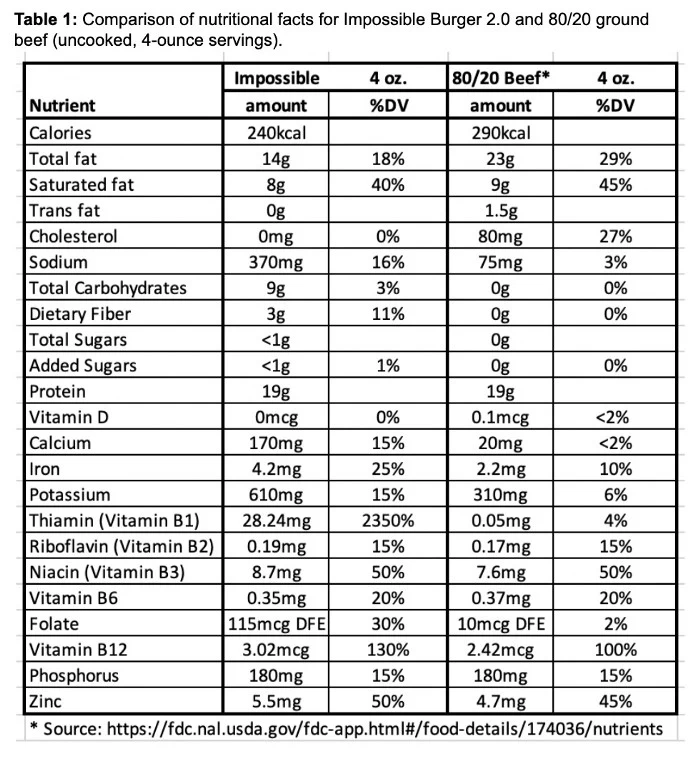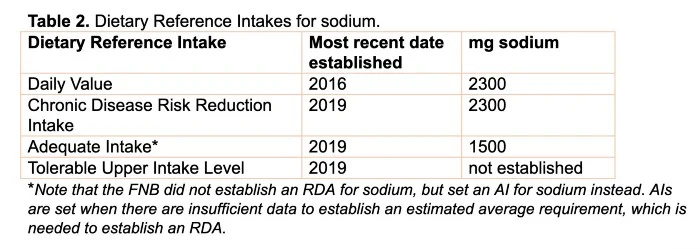Our Commitment to Nutrition and Health: Sodium and the Impossible Burger
By Dr. Sue Klapholz, VP of Nutrition and Health, Impossible Foods

Our mission is to improve the health of our planet by making delicious plant-based meat, and we take the health of our consumers just as seriously. When it comes to nutrition, we strive to be equivalent to, or better than, the animal-based products we replace.
The cow isn’t innovating. Impossible is.
When we first started working on the Impossible Burger™, we chose 80/20 ground beef as our benchmark because 20% fat is the standard for restaurant beef (1). The original Impossible Burger had a good nutritional profile, but we knew we could do even better. So we created Impossible Burger 2.0 with significant nutritional improvements. We lowered sodium by 36%, decreased saturated fat by 43%, added more fiber, improved the protein quality, and increased the amount of several essential micronutrients, including folate, calcium, potassium and zinc (2).
Impossible Burger 2.0 compared to 80/20 beef
A nutritional comparison of 4 ounces of uncooked Impossible Burger 2.0 (2) and 80/20 beef (3) is presented in Table 1. Both are excellent sources of protein, and both have equivalent amounts of many B vitamins, including riboflavin, niacin, vitamin B6 and vitamin B12, and essential minerals, including phosphorus and zinc. The Impossible Burger, however, has a better fat profile than 80/20 beef with 14g total fat, 8g saturated fat and 0mg cholesterol, compared to 23g total fat, 9g saturated fat and 80mg cholesterol in 80/20 beef. The Impossible Burger is also a better source of thiamin (vitamin B1), folate, calcium, iron and potassium.
The one nutrient that the Impossible Burger has drawn criticism for having “too much” of, compared to beef, is sodium. So let’s explore the dietary need for sodium and put the amount in a serving of Impossible Burger in perspective.

Sodium is essential for life
Sodium is an essential mineral. Essential minerals are minerals that our bodies need to survive. Sodium and chloride are the principal ions in extracellular fluid, which include blood plasma, cerebrospinal fluid, joint fluid, and interstitial fluid (fluid between cells) (4). Sodium plays a key role in regulating extracellular volume and blood pressure (4).
Dietary sodium intake
A teaspoon of table salt (sodium chloride) contains 2300mg of sodium (5). The average US adult consumes about 3400mg of sodium per day (5). Most of the sodium in our diet comes from salt that is added to food either during manufacturing, cooking or at the table (6). In fact, very little sodium occurs naturally in food. Sodium is added to food for many reasons, including to provide and enhance flavor, to improve texture, and to inhibit microbial growth. In the US, the largest contributor to salt in the adult diet after table salt is yeast breads and rolls (6).
Sodium guidelines
The most recent FDA nutritional regulations, which came into effect in 2016, set the daily value (DV) for sodium at 2300mg (7, Table 2). The percent DV on a nutritional fact panel serves as a guide for estimating the percent of your daily nutrient needs that are met by a serving of a particular food. It is important to note that for nutrients that people tend not to get enough of, such as iron and calcium, the DV is the aspirational target, but for nutrients that tend to be consumed in excess, such as sodium and sugar, the DV represents a conservative estimate of the highest amount a person should consume in a day (7).
To establish their 2016 dietary guidelines, including the DV of 2300mg for sodium, the FDA used recommendations from several agencies, including the Food and Nutrition Board (FNB) of the National Academies of Sciences, Engineering, and Medicine (7). The FNB establishes reference values for nutrients, which are used to develop nutrition recommendations for healthy populations. These reference values are collectively called the Dietary Reference Intakes (DRIs), and include the Recommended Dietary Allowance (RDA), the Adequate Intake (AI) and the Tolerable Upper Intake Level (UL) (6,7). RDAs and AIs are recommended intake values that are assumed to be sufficient for healthy individuals (7). This year, the FNB published their latest DRIs for sodium and set an AI for adults at 1500mg/day (6, Table 2).
A tolerable upper intake level (UL) reflects the highest level of daily intake of a specific nutrient likely to pose no risk of adverse health effects in almost all individuals of a specified age. The 2019 FNB review did not find sufficient evidence to set a UL for sodium (6). However, based on substantial evidence that lowering sodium intake is associated with lowered risks of hypertension and cardiovascular disease, the FNB set a Chronic Disease Risk Reduction Intake (CDRR) for sodium in healthy adults of 2300mg/day (6, Table 2). The 2015-2020 Dietary Guidelines for Americans (8), following the 2013 American Heart Association/American College of Cardiology Guideline (9), advise that adults with (pre)hypertension consume no more than 2300mg of sodium per day and, if possible, further reduce sodium intake to 1500mg per day for an even greater blood pressure-lowering effect.

Sodium and the Impossible Burger
According to the FDA, foods with ≤5%DV (≤115mg) per serving can be labelled “low sodium” and those with ≥20%DV (≥460mg) per serving are considered “high sodium” (5). A 4-oz. serving of the Impossible Burger contains 370mg of sodium (16%DV), a 3-oz. serving contains 280mg (12%DV) and a 2-oz. serving contains 190mg (8%DV). None of these servings meet the FDA definition of a high sodium food. After eating one 4-oz. Impossible Burger, you would still need to consume an additional 1130mg of sodium to reach the AI (the adequate daily intake value of 1500mg), or an additional 1930mg to reach the DV/CDRR (2300mg). Therefore, the Impossible Burger can easily fit into a low sodium diet. In fact, you could eat 1.5 pounds of Impossible Burger per day and still be below the daily value for sodium.
Sodium levels in beef
When compared to raw beef, the Impossible Burger has more sodium. Ground beef is naturally low in sodium with about 75mg sodium per 4-oz. serving (3). But it’s misleading to compare the Impossible Burger to unseasoned beef because beef is rarely eaten unseasoned. Hamburger recipes typically call for seasoning the beef with salt. For example, a 2016 article(opens in a new tab) on how to create the perfect patty suggests adding 1 tsp. salt (2300mg sodium) per pound of beef, the equivalent of 573mg sodium per 4-oz. patty (1). On the high end, another recipe(opens in a new tab) calls for ½ tsp table salt (1150mg sodium) per 5-oz. raw beef, the equivalent of 920mg sodium per 4 oz. patty (10). When eating burgers in “fast food” restaurants, total sodium intake can be quite high. Not only are the patties seasoned with salt, but they are often topped with salty condiments (e.g., ketchup and pickles), served on buns that contain a substantial amount of sodium, and accompanied by a side of salty fries. In these instances, regardless of whether the patty is the Impossible Burger or a beef burger, the total sodium content of the meal will be high.
Our ongoing commitment to nutrition and health
In going from Impossible Burger 1.0 to 2.0, we made a number of significant improvements to the nutritional profile of our product. Our goal for Impossible Burger 3.0 is to make it even better. While the Impossible Burger 2.0 is not a high sodium food, we know that lowering its sodium content further will give cooks more flexibility to create low sodium meals. We are currently working to lower sodium and saturated fat, while retaining the high-quality protein, fiber and essential micronutrients that consumers expect in the Impossible Burger. As always, our strong commitment to nutrition is paired with an effort to be as transparent as possible. We provide the science-based information behind our products so that you can make informed choices about what you put on your plate.
Questions, comments, thoughts? We welcome constructive conversation. Reach out to us at [email protected](opens in a new tab).
References
1. Steintrager, MO. How to grill burgers: Secrets to the perfect patty, Today. May 19, 2015 (updated June 30, 2016). http://www.today.com/food/how-grill-burgers-secrets-perfect-patty-t21941(opens in a new tab)
2. Impossible Foods Inc. website: https://impossiblefoods.com/(opens in a new tab)
3. USDA FoodData Central, https://fdc.nal.usda.gov/fdc-app.html#/food-details/174036/nutrients(opens in a new tab)
4. Oregon State University, Linus Pauling Institute, Micronutrient Information Center, Sodium (Chloride). Last updated 4/11/19. https://lpi.oregonstate.edu/mic/minerals/sodium(opens in a new tab)
5. US Food and Drug Administration. Sodium in your diet: use the Nutrition Facts label and reduce your intake. May 22, 2016. http://www.fda.gov/Food/ResourcesForYou/Consumers/ucm315393.htm(opens in a new tab).
6. National Academies of Sciences, Engineering, and Medicine. 2019. Dietary Reference Intakes for Sodium and Potassium. Washington, DC: The National Academies Press. https://doi.org/10.17226/25353(opens in a new tab).
7. Food Labeling: Revision of the Nutrition and Supplement Facts Labels A Rule by the Food and Drug Administration(opens in a new tab) on 05/27/2016(opens in a new tab). https://www.federalregister.gov/documents/2016/05/27/2016-11867/food-labeling-revision-of-the-nutrition-and-supplement-facts-labels(opens in a new tab)
8. US Department of Health and Human Services and US Department of Agriculture. 2015-2020 Dietary Guidelines for Americans. http://health.gov/dietaryguidelines/2015/guidelines/(opens in a new tab)
9. Eckel RH, Jakicic JM, Ard JD, et al. 2013 AHA/ACC guideline on lifestyle management to reduce cardiovascular risk: a report of the American College of Cardiology/American Heart Association Task Force on Practice Guidelines. Circulation. 2014;129(25 Suppl 2):S76-99.
10. Lopez-Alt, JK. December 11, 2009 (last updated October 31, 2019) The Burger Lab: Salting Ground Beef. http://aht.seriouseats.com/archives/2009/12/the-burger-lab-salting-ground-beef.html(opens in a new tab)